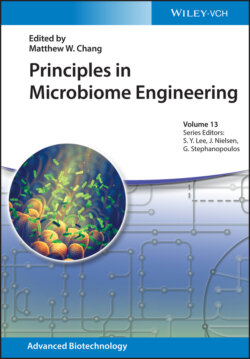Читать книгу Principles in Microbiome Engineering - Группа авторов - Страница 10
Preface
ОглавлениеThough unseen to the naked eye, microbiomes represent an invisible universe with much yet to be explored. From the diverse microbial communities found within our own bodies all the way to the soil's depths, the omnipresence of these microbiomes underlies their vital role in mediating biological processes. By offering a means to harness these microbes for societal benefit, microbiome engineering can pave the way for crucial interventions in everything from disease treatment to agricultural productivity.
Given the intricacy of interactions among microbes, it would be wise to comprehensively compile our state‐of‐the‐art knowledge on microbiome engineering. Written by leading experts, the volume's 10 chapters touch upon fundamental aspects – such as the microbiome's wide‐ranging influence on human health, disease, and agriculture; methods to engineer microbiomes for therapeutic and diagnostic applications, as well as insights into recent research directions that are shaping the field.
With probiotics capturing public imagination in recent years, Chapter 1 aptly introduces our current understanding of the human microbiome through the lens of diet and nutrition. Chapter 2 builds upon this foundation by exploring how microbiome engineering can modulate common metabolic disorders from diabetes to cardiovascular disease.
While microbes are popularly perceived as “villains” in the quest for health, Chapter 3 challenges this notion by describing the myriad ways microbes can be repurposed to sense, respond to, and even treat diseases. Rounding out the volume's initial focus on human health, Chapter 4 details specific considerations when engineering probiotics to be better adapted to the gut.
Chapter 5 moves onto another equally fascinating – and important – application of microbiome engineering: precision agriculture, where minute variations in crop data are gathered and leveraged to improve yield and quality. Given the delicate balance of microbiomes, Chapter 6 provides an overview of the different biological sensors being developed to detect even the slightest of perturbations, such as riboswitches and transcription factors.
Meanwhile, Chapter 7 focuses on how synergistic interactions among microorganisms can be further enhanced by engineering synthetic microbial consortia. Already ubiquitous in nature, advancing the design of microbial consortia could lead to breakthroughs in bioprocessing and bioremediation, among others. Proving that waste can indeed be turned into wonder, Chapter 8 describes the emerging treatment that is fecal microbiota transplantation, from the protocols involved to its clinical applications.
With early‐life microbiota increasingly linked to long‐term health and disease, Chapter 9 shines a spotlight on the maternal microbiota and the many factors affecting its impact on newborn infants. Finally, this volume concludes in Chapter 10 by diving deep into a powerful technique in the microbiome engineering toolkit: transcription factor‐based biosensors, first introduced in Chapter 6.
I would like to extend my deepest gratitude to the experts at the forefront of microbiome engineering for their contributions. By sharing their insights through the written word, I hope that this volume will be an indispensable resource that new generations of researchers can refer to as they add to the growing body of knowledge on microbiome engineering.
| Singapore, April 2022 | Matthew W. Chang National University of Singapore |
